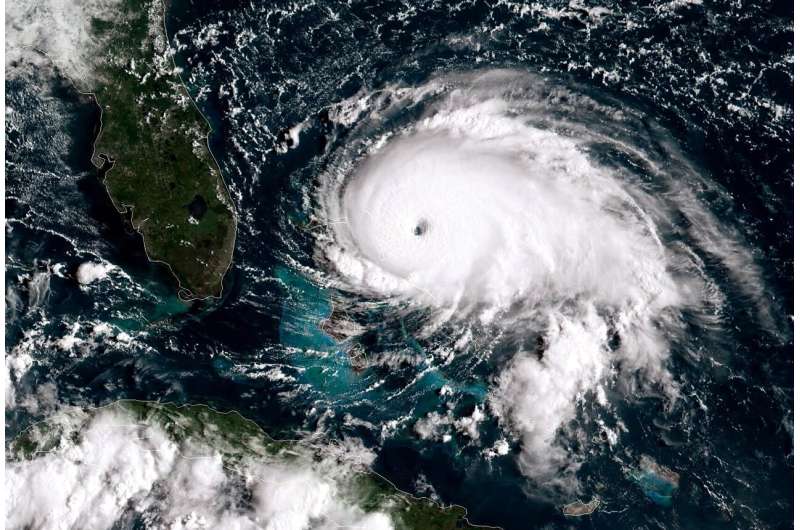This article has been reviewed according to Science X's editorial process and policies. Editors have highlighted the following attributes while ensuring the content's credibility:
fact-checked
trusted source
proofread
How are hurricanes named? Experts explain how naming conventions for major storms have evolved over the years

The state of Texas is no stranger to hurricanes and damaging storms. Texas A&M AgriLife Extension Service Disaster Assessment and Recovery, DAR, continues to assist Texans recovering from Hurricane Beryl amidst what is expected to be an above-average Atlantic hurricane season.
Anyone who has ever been through a hurricane or witnessed the aftermath can certainly recall the storm by name.
"Back in 2008, probably the first time AgriLife Extension did a major emergency response was for Hurricane Ike," said Dr. Monty Dozier, DAR program director. "That was the first time we engaged as an animal responder to that magnitude, and it was one of the largest livestock recovery operations ever in the history of the U.S. And when Hurricane Harvey hit in 2017, we worked well into the following year helping Texans recover and rebuild."
The DAR unit works in partnership with the Texas Division of Emergency Management, part of The Texas A&M University System. Even before the formation of DAR, AgriLife Extension agents were a key part of the emergency assistance network ready to serve Texans in the wake of hurricanes.
"They are names you never forget," Dozier said. "They are also names you never want to hear again."
Naming protocol changes over the years
Before they ever made landfall, the names of Hurricane Ike, Hurricane Harvey and many others were known. But that wasn't always the case.
Originally, hurricanes were named after the fact. They were also typically assigned their name according to where and when they made landfall, such as the Galveston Hurricane of 1900 or the Galveston Hurricane of 1915.
As the science of weather forecasting advanced, storms were identified by their latitude-longitude, but this confused most people. When tracking and flying into hurricanes increased, the NATO phonetic alphabet came into use—think Alpha, Bravo, Charlie, Delta, Echo and Foxtrot.
It wasn't until 1953 when the National Hurricane Center started the first name list. Initially, all hurricanes were given female names. This changed in 1979 when male names were added to the list.
Today, storms receive names in alphabetical order as they form. With Hurricane Beryl, for example, the name tells us it was the second-named storm of the Atlantic season following Tropical Storm Alberto in June.
"This year, the NOAA National Weather Service outlook for the Atlantic hurricane season, which spans from June 1 to Nov. 30, predicts an 85% chance of an above-normal season," said Dr. John Nielsen-Gammon, Texas state climatologist and Regents Professor in the Texas A&M College of Arts and Sciences Department of Atmospheric Sciences.
What each storm will be named is known well in advance, as there is a master list in use each year. The list of storm names for the North Atlantic is recycled every six years, which means the names we hear in 2024 will reappear in 2030, with a few exceptions.
Retiring a hurricane name
The World Meteorological Organization decides if a particular hurricane is of sufficient historical interest to have the name retired, Nielsen-Gammon said. There are names it would not be appropriate to use again.
Hurricane names are retired due to human and property losses associated with the storm. That's why you will never see another hurricane named Katrina or Harvey.
"There are anywhere from zero to four or five names retired each year, depending on how active and impactful any given season is," Nielsen-Gammon said.
If it is a particularly busy storm season, tracked storms may use up the names designated for that year. This happened in both 2005 and 2020, and the Greek alphabet was then utilized for the remaining storms, which caused confusion. Zeta, for example, is the sixth letter of the Greek alphabet but people could understandably think it was the last. Now a list of back-up names is kept at the ready.
In other parts of the world, like the Central Pacific, once the list of names runs out, they continue onto the next list.
Supporting Texans, regardless of the name
With a presence in all 254 Texas counties, AgriLife Extension is prepared to embed local disaster response teams in communities when needed. This comprehensive network positions DAR as one of the most unique and effective disaster response infrastructures in the nation.
In an active hurricane season, multiple storms can be swirling at the same time. Knowing which specific ones are strengthening or weakening is crucial for preparation and planning, Dozier said. Names keep everyone on the same page.
"Texas represents over 20% of the U.S. coastline along the Gulf of Mexico, so we are always watching these storms and ready to respond to A through W—the last letter we use for hurricane names—if need be," he said.
Provided by Texas A&M University


















